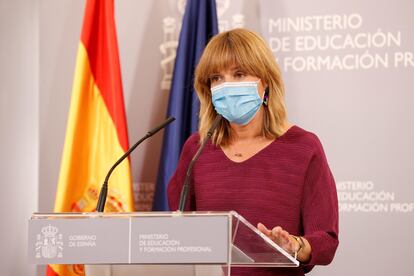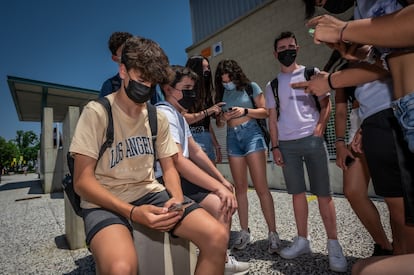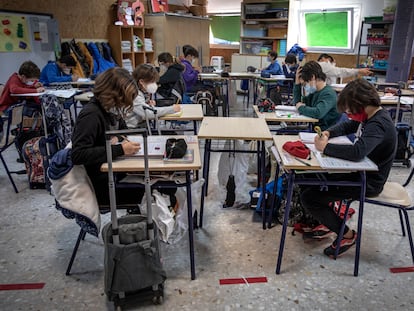Covid-19 measures to remain in Spanish schools, with obligatory masks but larger class sizes
The central government and the regions are considering exempting vaccinated students from quarantines. There are also plans to hire thousands of extra teaching staff

The Education Ministry and Spain’s autonomous regions decided on Wednesday to keep in place the coronavirus measures approved in May, prior to the fifth wave of the pandemic when the 14-day cumulative number of coronavirus cases per 100,000 inhabitants was less than half what it is now – there were 139 cases per 100,000 on May 20, compared to the 291 reported on Wednesday. The decision is in line with the requests of families and teaching staff.
Alegría told reporters that almost €13.5bn has been allocated by the central government to the regions to adapt their public services to the pandemic
The document does, however, propose an increase in the number of students per classroom compared to the school year that ended in June. The rapid rate of vaccination among adolescents, with 63.4% of the population aged 12 to 17 having already received one dose and 18.3% fully vaccinated, together with the successful implementation of measures during the last academic year, has prompted the education authorities to decide that the regulations put in place three months ago remain sufficient.
The two main changes with respect to the previous school year are an increase in the ratios for students aged under six – 25 children per classroom up from 20 – and the permitted distance between high school students reduced from 1.5 meters to 1.2 meters.
Following the meeting with the regional authorities, Education Minister Pilar Alegría stressed that the collective aim for the next academic year is to guarantee face-to-face classes, which most of the regions were unable to offer to secondary students last year. The Madrid region proposed that the measures be relaxed already, but the general consensus among the regions – who are in charge of their education systems – was to start the academic year with the already-approved measures and adapt them according to developments, an approach echoed by Alegría in her closing statement, in which she called for “prudence.”
The central government and the regions are also working together to adapt the guidelines for monitoring Covid-19 cases. The principal change that has been proposed is that vaccinated high school students will not have to quarantine when a positive case is detected in their class, in line with other European countries, such as France. That’s according to sources with knowledge of the negotiations who have spoken to EL PAÍS.
Teacher recruitment
Alegría told reporters on Wednesday that almost €13.5 billion has been allocated by the central government to the regions to adapt their public services to the pandemic. The sum will be delivered between October and November and she has asked the regions to make education “a priority” when it comes to its distribution. The prospect of the extra budget, together with the smaller injections of funds from the Education Ministry in recent months, has already led some regions to announce the recruitment of several thousand extra teachers, as happened last year, with Valencia now hiring an additional 5,042, Andalusia, 5,000 and the Madrid region, 2,931. While Catalonia aims to announce its recruitment plans in the next few days, it is expected that all 17 regions will hire extra staff, though the numbers may be fewer than the more than 35,000 recruited last year.
Spain’s school year will begin next week with news that, while encouraging, is also generating a degree of uncertainty. The full vaccination of nearly 70% of the general population and almost all teachers, along with more than half of students aged 12 to 17 having had at least one dose, is reassuring. Yet the spread of the delta variant, which is more contagious, together with the increase in the number of students per class, is inevitably of concern for teachers, families and epidemiologists. However, the latter have stressed that the two most important measures to avoid infection are being maintained: the ventilation of classrooms and the mandatory use of masks from the age of six upward.
Last year, the preventative measures allowed Spain to keep schools open for the entire academic year, with the percentage of classes in lockdown below 2% on average. Almost all other developed countries had to either partially or fully cancel face-to-face classes at some point over the year.
A study published by Sergio Alonso, from the Polytechnic University of Catalonia’s Computational Biology and Complex Systems group (BIOCOM-SC), in The Pediatric Infectious Disease Journal in July, indicates that the combination of the students’ low transmission capacity, especially among the youngest, and the preventative measures kept the infection rate at very low levels last year, though it did increase with age; each student testing positive for Covid-19 infected an average of 0.4 people, with infants infecting 0.2; primary school children 0.4; and high school students 0.6.
Low transmission rates
Alonso’s data refers to the first quarter of the academic year in Catalonia – the region that has been providing most of the information on the incidence of Covid-19 in schools. But Alonso has also studied data from the following two quarters when the alpha strain of the coronavirus – initially known as the British variant, and which was more contagious than the previous one – had already spread. The research shows that, although the level of transmission increased in infants rising from 0.2 to 0.3, it hardly changed in primary and secondary schools. There is as yet no information on the impact of the delta variant, which began to spread at the end of the school year. Alonso expects the strain to have increased the transmission rate and is in favor of maintaining last year’s preventative measures. But he also believes that transmission will remain below 1, the threshold beyond which schools would become transmission hotspots.

According to the epidemiologist Salvador Peiró, experience shows that the rate of transmission among children and adolescents is far higher during vacations when social interaction increases and adult supervision is relaxed. In other words, the return to school should, in principle, have a positive effect on the incidence among children and adolescents. But in the school year about to begin, there is a chance that the new factors such as the more-infectious delta variant may have an effect. “The problem is that we don’t know to what extent,” says Peiró.
Uncertainty
Most of the uncertainty is confined to secondary schools. On the one hand, there is the reduction in the distance between students from 1.5 meters to 1.2 meters, which means more students to a class than last year. In terms of surface area, this interpersonal distance translates to 1.44 square meters per student, i.e., more than the statutory space during the last 30 years, though in old buildings and those with very full classes, alternative spaces will have to be created. But the end of mixed face-to-face and remote learning, which has been how schools have operated in most of Spain, will mean that a high school that accommodated 600 students a day last year will now be flooded with more than a thousand, with the increase in interactions that this implies between classes.
On the other hand, about half of secondary school students will be fully vaccinated when classes start, according to region, between September 6 and 15. And it is predicted that all students will be able to get vaccinated by November.
Meanwhile, the increase in the maximum number of students per class in primary schools should not imply significant changes in potential transmission rates. Although there may be up to 30 students in some classes, almost all the regions will limit classes to 25 – on a par with last year in at least some areas. Meanwhile, there will be an increase in the ratios, from 20 to a maximum of 25, among infants, a demographic that will not be obliged to wear masks but whose transmission capacity is lower.
English version by Heather Galloway.
Tu suscripción se está usando en otro dispositivo
¿Quieres añadir otro usuario a tu suscripción?
Si continúas leyendo en este dispositivo, no se podrá leer en el otro.
FlechaTu suscripción se está usando en otro dispositivo y solo puedes acceder a EL PAÍS desde un dispositivo a la vez.
Si quieres compartir tu cuenta, cambia tu suscripción a la modalidad Premium, así podrás añadir otro usuario. Cada uno accederá con su propia cuenta de email, lo que os permitirá personalizar vuestra experiencia en EL PAÍS.
¿Tienes una suscripción de empresa? Accede aquí para contratar más cuentas.
En el caso de no saber quién está usando tu cuenta, te recomendamos cambiar tu contraseña aquí.
Si decides continuar compartiendo tu cuenta, este mensaje se mostrará en tu dispositivo y en el de la otra persona que está usando tu cuenta de forma indefinida, afectando a tu experiencia de lectura. Puedes consultar aquí los términos y condiciones de la suscripción digital.
More information
Últimas noticias
Most viewed
- Sinaloa Cartel war is taking its toll on Los Chapitos
- Reinhard Genzel, Nobel laureate in physics: ‘One-minute videos will never give you the truth’
- Oona Chaplin: ‘I told James Cameron that I was living in a treehouse and starting a permaculture project with a friend’
- Why the price of coffee has skyrocketed: from Brazilian plantations to specialty coffee houses
- David King, chemist: ‘There are scientists studying how to cool the planet; nobody should stop these experiments from happening’











































